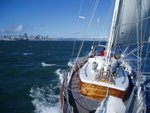By popular demand... here is a quick post explaining how we can send and receive emails when at sea. We have been successfully using
SailMail.
The SSB is using an analogous signal. Emails are digital data. That is why you need a modem (
MOdulator-
DEModulator) between the radio and the laptop, to convert the analogous signal into a digital one, and vice-versa.
So, on the boat, you need: a laptop, a modem, an SSB, with its antenna. You also do need the SailMail client program, which knows how to communicate with the modem and the SSB. All details about that are given on the
SailMail web site.
The SailMail association has a network of land radio stations, which can receive the signals emitted by the boats. The land stations also have a modem, and are connected on the Internet. The emails rely on the Internet. It is like if the land stations had two faces: one facing the sea (with the SSB), and one facing the web (with the Internet connection).
What happens when the boat sends an email:
On the boat, you compose your email, and you put it in your outbox. Then you turn your SSB on, and you use the SailMail client program to contact a land SailMail station.
When the contact is established, the messages sitting in the outbox go through the modem and the SSB to be streamed to the land station. On receive, the land station then turns the messages back into digital files, and uses its Internet connection to post them on the web. From there, it's the usual email story.
What happens when an email is sent to the boat:
Someone has been sending the boat an email, using its
@sailmail.com address.
When boat is establishing a connection with a land station - just like above - the land station is converting the digital emails sitting in your SailMail inbox into an analogous signal, so they can be streamed to the boat.
On the boat side, when those messages are received, they're converted into emails, and put into your SailMail client inbox on your laptop. That's it!
The radio transmission is
very slow, compared to what DSL and others can provide.
Remember the dial-in time? Well, divide it by ten, and you're not even close...
That's why SailMail is appropriately cutting any attachment to the incoming emails..., and that's why, if you reply to a SailMail email,
please do not hit the reply button without cutting the original message! Thank you.
A SailMail subscription grants you 90 minutes of transmission per week. Transmission time also include the time it takes to receive unwanted messages (like the original message, the one
you replied to without cutting it). Thanks again.















